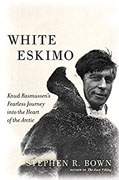White Eskimo
Stephen R. Bown
book reviews:
· general fiction
· chick lit/romance
· sci-fi/fantasy
· graphic novels
· nonfiction
· audio books
· author interviews
· children's books @
curledupkids.com
· DVD reviews @
curledupdvd.com
newsletter
win books
buy online
links
home
for authors
& publishers
for reviewers

 |
White Eskimo: Knud Rasmussen's Fearless Journey into the Heart of the Arctic Stephen R. Bown Da Capo Press Hardcover 384 pages November 2015 |
|
Igjugarjuk, an Eskimo chief (an angakoq, which means shaman) from near west Hudson Bay, believed that Arctic explorer Knud Rasmussen “was the first white man he had ever seen who was also an Eskimo.”
On his explorations, Rasmussen ate duck eggs, caribou, walrus, and whale, seldom had fresh water, and not infrequently fell off his sled into the frigid water. Their diet contained no vegetables and little fruit or berries. Chronic illness threatened his crews. Rasmussen made several months- to years-long travels into Alaska, Russia, Greenland, and other spots north of the Arctic Circle. He wrote more than one dozen books in a somewhat literary style about the inhabitants, recording their life stories, legends, and poetry. He never lost his passion for the people and for their cultures and apparently preferred their lives to his more ‘sophisticated,” comfortable one in Denmark, to which he periodically returned, of course, to visit family and to fundraise for future expeditions. His most famous expedition was named The Fifth Thule Expedition. Begun in 1923, this was an extensive five-year search involving many men, dogs, and sleds to document the origins of the Inuit peoples. It became “the longest dogsled expedition in polar history.” Rasmussen was considered kind to his many canines, without whom he could never have gone to the places he ventured. Relates Therkel Mathiassen, one of many traveling companions, “He loved his dogs so they loved him, not with the slavish lickspittle affection of civilized dogs, but with the half-wild beast’s feeling of ‘belonging’ in thick and thin.” Of course, Rasmussen was not at all deranged, just extremely hardy, determined, and passionate about his life’s work: Far North exploration. As the author points out, “He was an explorer of people rather than geography.” In his decades of pioneering travel, Rasmussen brought the Inuit/Eskimo peoples into the world’s consciousness--wanting to save their cultures, languages, traditions, and stories and to open up trading posts and international understanding so that they became more part of the known world. He did not want to change these remote people, who most often lived in settlements of only five or six huts in a bleak, freezing atmosphere; he did not demand they become “European.” He found them ingenious, hardy, and magical in their storytelling. Rather, he wanted to observe and record them before civilization came to and changed them, as it usually does. “I determined to begin by doing nothing,” Rasmussen wrote, “but simply to live amongst them, be as communicative as possible myself, and wait for an opportunity when the desire to narrate should overmaster their reserve.” The book is inspiring in an odd way. Not too many contemporary readers would want to do exactly this, but this reader is in awe of someone who would take on such uncomfortable, demanding activities repeatedly over the comforts of more "civilized" society and family. Rasmussen’s is an incredible and inspiring life. However, because White Eskimo I admire Rasmussen (and author Stephen R. Bown, for his style and his impeccable research), but I would have been happy to read a bit shorter biography. Fascinated with history and tireless, hardy heroes, Bown has also written a biography of Rasmussen’s contemporary explorer, Roald Amundsen. However, Bown’s book did inspire me to watch Rasmussen’s film, “The Wedding of Palo,” partially available on YouTube, and to attempt to track down the explorer’s books on northern folktales and culture. Several maps and black-and-white photographs help the reader understand the distances and the hardships Rasmussen, his crews, and his dogs endured over the years. Short portions of Rasmussen’s writing are included, and a splendid bibliography, of sources and of its subject’s writing, concludes the book. Originally published on Curled Up With A Good Book at www.curledup.com. © Deborah Straw, 2016 |
| Also by Stephen R. Bown: |
|
|
|
 Click here to learn more about this month's sponsor! |
|
| fiction · sf/f · comic books · nonfiction · audio newsletter · free book contest · buy books online review index · links · · authors & publishers reviewers |
|
| site by ELBO Computing Resources, Inc. | |
 Knud Rasmussen (1879–1933) was fearless, charismatic, and some might even say downright nuts. He grew up in Denmark and in Greenland and had Danish and Inuit blood. Although he had a wife and children in Denmark, he was often gone for years for voyages into the far north, on dogsleds, in below zero temperatures under frequent totally dark skies. His wife, Dagmar, remained
(by choice) in Copenhagen during their long separations.
Knud Rasmussen (1879–1933) was fearless, charismatic, and some might even say downright nuts. He grew up in Denmark and in Greenland and had Danish and Inuit blood. Although he had a wife and children in Denmark, he was often gone for years for voyages into the far north, on dogsleds, in below zero temperatures under frequent totally dark skies. His wife, Dagmar, remained
(by choice) in Copenhagen during their long separations.